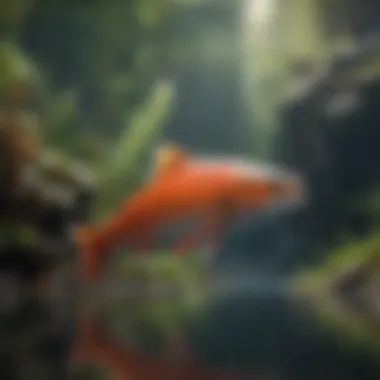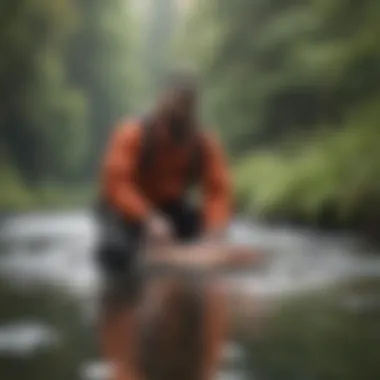Unveiling the Crucial Role of Salmon Habitats in Environmental Preservation


Overview of the Topic
Salmon habitats play a crucial role in environmental conservation efforts. These habitats are essential for maintaining biodiversity and ecosystem balance. The intricate relationship between salmon and their habitats underscores the importance of preserving these areas for the overall well-being of the environment.
Current Status and Challenges
Presently, salmon habitats face numerous challenges that endanger their sustainability. Human activities such as habitat destruction, pollution, overfishing, and climate change pose significant threats to these important ecological zones. Understanding the current state of salmon habitats is crucial in formulating effective conservation strategies.
Sustainable Solutions
Exploring sustainable solutions is imperative in safeguarding salmon habitats. Implementing habitat restoration projects, regulating fishing practices, reducing pollution, and mitigating the impacts of climate change are key steps in ensuring the longevity of these crucial ecosystems. Successful case studies serve as inspiring examples of effective resource management practices.
Impact and Importance
The impact of salmon habitats extends beyond the aquatic realm, affecting ecosystems, communities, and future generations. By conserving these habitats, we not only preserve biodiversity but also protect valuable resources that benefit both wildlife and humans alike. Emphasizing the importance of conservation efforts is vital for promoting sustainable resource use and securing a healthier environment for all.
Understanding Salmon Habitats
In the intricate web of environmental conservation, understanding salmon habitats emerges as a critical component. These habitats serve as vital ecosystems that sustain the unique lifecycle of salmon, contributing significantly to biodiversity. By exploring the nuances of salmon habitats, we gain valuable insights into the interconnectedness of nature's balance.
The Lifecycle of Salmon
Salmon navigate through various stages in their lifecycle, each holding paramount importance to their survival and the ecosystem's equilibrium.
Egg Stage
The egg stage marks the beginning of the salmon's journey, where they are deposited in riverbeds. These eggs require pristine water conditions to hatch successfully, emphasizing the significance of healthy river habitats for the propagation of salmon populations. The resilience of salmon eggs is remarkable, showcasing nature's intricate design for species continuity and ecosystem stability.
Alevin Stage
Following the egg stage, alevins emerge, characterized by their distinct yolk sacs providing essential nutrients for growth. This phase is critical for the development of young salmon, setting the foundation for their future survival. The alevin stage underscores the delicacy of salmon habitats, highlighting the necessity of undisturbed environments for optimal growth.
Fry Stage
As alevins mature, they transition into the fry stage, where they actively feed and establish territories within their habitat. The fry stage marks a crucial period where salmon adapt to their surroundings, honing their survival instincts. This phase underscores the importance of habitat diversity, offering a range of resources for salmon to thrive.
Smolt Stage
Upon reaching the smolt stage, young salmon undergo significant physiological changes to prepare for the migration to the ocean. This developmental phase is imperative for salmon to adapt to saltwater environments, signaling a pivotal moment in their lifecycle. The smolt stage highlights the interconnectedness of river and ocean habitats, showcasing the intricate balance necessary for salmon survival.
Adult Stage
Finally, adult salmon return to their natal rivers for spawning, completing the cycle of life. These mature salmon play a crucial role in propagating future generations, maintaining the delicate ecosystem balance. The adult stage exemplifies the cyclical nature of salmon habitats, emphasizing the continuous interplay between salmon populations and their environments.
Key Habitats for Salmon Survival


Salmon rely on distinct habitats for their survival, each playing a crucial role in ensuring their well-being and ecological impact.
Rivers and Streams
Rivers and streams provide essential breeding grounds and migration pathways for salmon populations. These freshwater habitats offer spawning sites and shelter for young salmon, fostering their development within intricate aquatic ecosystems. The conservation of healthy river and stream habitats is paramount for sustaining salmon populations and preserving biodiversity.
Estuaries
Estuaries serve as vital transitional zones where rivers meet the ocean, offering a diverse ecosystem crucial for salmon migration. These dynamic environments provide abundant food sources and protection for migrating salmon, enabling their successful transition from freshwater to saltwater habitats. The preservation of estuaries is essential for supporting the interconnected lifecycle of salmon and promoting ecosystem resilience.
Ocean Migration Routes
During their oceanic phase, salmon traverse vast migration routes, navigating through complex marine landscapes. These migration routes are fundamental for salmon populations to access feeding areas and complete their lifecycle. Understanding and safeguarding ocean migration routes are critical for ensuring the survival of salmon populations and maintaining the ecological balance of marine ecosystems.
2. Threats to Salmon Habitats
In understanding the significance of salmon habitats within the realm of environmental conservation, it is imperative to delve into the array of threats that these habitats face. These threats pose substantial risks to the delicate balance of ecosystems, impacting not only salmon populations but also the broader biodiversity and ecological stability. By highlighting these threats, we can better grasp the urgency of conserving salmon habitats and the pivotal role they play in maintaining environmental health.
Habitat Degradation
Pollution
The issue of pollution stands out as a critical factor in the degradation of salmon habitats. Pollution, in various forms such as chemical runoffs, plastics, and toxins, poses a grave threat to the well-being of salmon populations. The detrimental impacts of pollution on water quality and aquatic life are profound. Despite numerous regulations and advancements in waste management, pollution remains a persistent challenge that requires continuous monitoring and remedial actions to safeguard salmon habitats.
Deforestation
Deforestation contributes significantly to the degradation of salmon habitats, particularly by altering watershed dynamics and increasing sedimentation levels in rivers and streams. The indiscriminate removal of trees not only disrupts natural habitats but also diminishes the vital ecological functions provided by forested areas. Addressing deforestation through reforestation efforts and sustainable land management practices is paramount in mitigating its adverse effects on salmon habitats.
Urbanization
The rapid pace of urbanization exerts pressure on salmon habitats through habitat fragmentation, channel modification, and increased pollution inputs. Urban developments encroach upon vital riparian zones and wetlands, disrupting the connectivity and functionality of aquatic ecosystems. Implementing green infrastructure projects and smart urban planning strategies can help mitigate the impacts of urbanization on salmon habitats, ensuring their long-term resilience and ecological integrity.
Overfishing
The phenomenon of overfishing threatens the sustainability of salmon populations globally, jeopardizing the delicate balance of aquatic ecosystems. Commercial fishing practices, driven by high demand and economic incentives, often exceed the natural reproductive capacity of salmon stocks, leading to population declines and ecological imbalances. By understanding the implications of overfishing, stakeholders can implement responsible harvesting practices and effective fisheries management strategies to safeguard the future of salmon populations.
Commercial Fishing
The intensification of commercial fishing operations poses a significant threat to salmon populations due to overexploitation and bycatch issues. Large-scale fishing vessels equipped with advanced technologies target salmon stocks intensively, compromising the resilience of these populations and jeopardizing their genetic diversity. Balancing economic interests with conservation priorities is essential in ensuring the sustainable management of commercial fisheries and the long-term viability of salmon populations.
Bycatch Issues
The incidental capture of non-target species, known as bycatch, remains a pressing issue in many fisheries targeting salmon. Bycatch contributes to considerable unintended mortality of marine organisms, including marine mammals, seabirds, and other fish species, disrupting ecosystem dynamics and biodiversity. Mitigating bycatch through gear modifications, selective fishing practices, and stringent regulatory measures is crucial in minimizing the collateral damage inflicted on non-target species and preserving the ecological balance of marine ecosystems.
Climate Change Effects
The pervasive impacts of climate change pose additional challenges to salmon habitats, exacerbating existing stressors and magnifying the vulnerabilities of salmon populations. Warming waters and ocean acidification, driven by climate change trends, alter aquatic environments significantly, affecting the physiological processes and distribution patterns of salmon species. Adapting to these climate-induced changes and implementing climate-resilient conservation strategies are essential in ensuring the persistence of salmon habitats amidst evolving environmental conditions.


Warming Waters
Rising water temperatures pose a grave threat to salmon populations by influencing their reproductive success, migration patterns, and overall survival rates. Increasing temperatures alter the availability of suitable habitats for salmon, leading to shifts in their distribution and potentially limiting their access to critical spawning grounds. Monitoring water temperature trends and implementing habitat restoration projects are crucial steps in mitigating the adverse effects of warming waters on salmon populations and preserving their ecological significance.
Ocean Acidification
The acidification of oceans, driven by elevated carbon dioxide levels, poses a significant challenge to salmon habitats by disrupting the marine food web and affecting the growth and development of salmon species. Acidification impacts the ability of marine organisms to form protective shells and skeletons, altering the availability of prey species for salmon and potentially triggering cascading effects throughout marine ecosystems. Addressing ocean acidification through carbon emission reductions and ocean conservation measures is vital in protecting the integrity of salmon habitats and securing the well-being of marine biodiversity.
3. Conservation Efforts and Solutions
In this section, we delve deep into the key aspects of conservation efforts and solutions related to salmon habitats in environmental conservation. The conservation of salmon habitats is crucial for maintaining ecosystem health and biodiversity. Implementing effective strategies to restore and protect these habitats is essential for the long-term survival of salmon populations. Conservation efforts focus on various elements such as habitat restoration, community involvement, and policy initiatives.
Salmon Habitat Restoration
Dam Removal Projects
Dam removal projects play a critical role in restoring natural river systems and improving salmon migration patterns. By dismantling obsolete dams, barriers to fish passage are eliminated, allowing salmon to move freely through their natural habitat. This restoration approach enhances salmon populations and promotes biodiversity in rivers and streams. Despite some challenges and controversy, dam removal projects offer significant benefits by revitalizing aquatic ecosystems and supporting the recovery of salmon populations.
Riparian Zone Protection
Riparian zone protection involves safeguarding the areas adjacent to water bodies where salmon spawn and seek refuge. By preserving riparian habitats, the quality of water sources is maintained, providing optimal conditions for salmon survival. This protection strategy helps to prevent erosion, reduce pollution, and enhance the overall health of salmon habitats. Although riparian zone protection requires continuous monitoring and resources, its positive impact on salmon populations and ecosystem stability is invaluable.
Community Involvement
Volunteer Programs
Volunteer programs engage local communities in hands-on conservation activities to protect and restore salmon habitats. Volunteers contribute their time and effort to activities such as habitat restoration, water quality monitoring, and public awareness campaigns. Through volunteering, individuals develop a sense of stewardship towards the environment and play a direct role in preserving salmon habitats. While volunteer programs rely on community support and resources, they offer a powerful means of fostering environmental literacy and active participation in conservation efforts.
Educational Campaigns
Educational campaigns raise awareness about the importance of salmon habitats and the need for conservation action. These campaigns target diverse audiences, including schools, businesses, and local organizations, to promote sustainable practices and habitat protection. By providing information on salmon biology, environmental threats, and conservation strategies, educational campaigns empower individuals to make informed decisions that benefit salmon populations. Despite the challenges of reaching a wide audience and sustaining interest, educational campaigns are instrumental in fostering a culture of environmental responsibility and advocacy.
Policy Initiatives
Habitat Protection Laws
Habitat protection laws establish legal frameworks to safeguard critical salmon habitats and enforce conservation measures. These laws regulate land use, water management, and development activities to prevent habitat destruction and degradation. By setting clear guidelines for habitat protection, laws ensure that salmon habitats are preserved for future generations. While enforcement and compliance issues may pose challenges, habitat protection laws form the foundation of conservation efforts and play a vital role in upholding ecosystem integrity.
Fisheries Management Regulations
Fisheries management regulations govern fishing practices and harvesting activities to prevent overexploitation of salmon populations. These regulations set catch limits, gear restrictions, and conservation quotas to sustainably manage fisheries and protect spawning grounds. By monitoring fishing activities and enforcing sustainable practices, regulations contribute to maintaining healthy salmon populations in their natural habitats. While balancing economic interests and conservation goals can be complex, fisheries management regulations are essential for ensuring the long-term viability of salmon populations and supporting ecosystem resilience.
4. Interconnectedness of Salmon with Ecosystem
In this significant section, we delve into how salmon are intricately connected with the ecosystem, playing a pivotal role in maintaining balance and biodiversity. Salmon not only serve as a crucial species in the food chain but also contribute to various ecosystem functions that are essential for a healthy environment. Through their life cycle, from spawning in freshwater to migrating to the ocean and back, salmon interact with different components of the ecosystem, influencing nutrient cycling, predator-prey relationships, and more.


Role of Salmon in Ecosystem
Nutrient Cycling
Nutrient cycling is a fundamental aspect of how salmon impact the ecosystem. When salmon return from the ocean to spawn in freshwater, they bring important marine-derived nutrients that enrich the freshwater environment. This influx of nutrients enhances the growth of aquatic vegetation, algae, and invertebrates, supporting the entire food web. Nutrient cycling by salmon contributes significantly to the productivity and health of both freshwater and marine ecosystems.
Predator-Prey Relationships
Salmon play a vital role in predator-prey relationships within the ecosystem. As a key food source for many predators, including bears, eagles, and other fish species, salmon help maintain the balance of predator and prey populations. By influencing the distribution and abundance of predators, salmon impact the entire ecosystem's structure and dynamics. Additionally, predation on salmon carcasses after spawning contributes to nutrient cycling, further illustrating the interconnectedness of salmon with the ecosystem.
Impact of Salmon Decline
Cascade Effects
The decline of salmon populations can have cascading effects throughout the ecosystem. Reduced salmon numbers lead to lower nutrient inputs in freshwater habitats, affecting plant growth, insect populations, and other species that depend on these nutrients. This disruption can impact entire food webs and alter ecosystem dynamics, ultimately leading to reduced biodiversity and ecosystem resilience.
Ecosystem Imbalance
Salmon decline can also contribute to ecosystem imbalance by disrupting predator-prey relationships and nutrient cycling. Declining salmon populations can create food shortages for predators, leading to their population declines. This imbalance can have far-reaching effects, triggering unexpected changes in species distributions, population sizes, and overall ecosystem stability. The interdependence of salmon within the ecosystem highlights the critical importance of conserving and protecting these keystone species for the health of the entire environment.
5. Future Perspectives on Salmon Conservation
In the ever-evolving landscape of environmental conservation, contemplating the future of salmon habitats holds paramount importance. The preservation of these crucial ecosystems necessitates a proactive approach that incorporates technological innovations, research and monitoring endeavors, and global collaboration. The forward-looking trajectory of salmon conservation hinges upon embracing cutting-edge methods and strategies to safeguard the delicate balance of aquatic habitats. As we delve into the forthcoming dynamics of salmon conservation, it becomes evident that technological advancements play a pivotal role in shaping the future landscape of environmental stewardship.
Technological Innovations
Tracking Systems
Integrating tracking systems into salmon conservation initiatives revolutionizes our ability to monitor and comprehend the movements and behaviors of these iconic fish species. These sophisticated systems leverage satellite technology to track salmon migration patterns, vital in understanding their distribution across vast aquatic ecosystems. By employing tracking systems, researchers can acquire real-time data, facilitating informed conservation decisions and enhancing our overall understanding of salmon behavior. The precision and accuracy offered by tracking systems elevate them as indispensable tools in the arsenal of environmental conservationists.
Genetic Monitoring
Genetic monitoring opens a gateway to unlocking the genetic diversity and health of salmon populations, offering profound insights into their adaptive capabilities and susceptibility to environmental stressors. This innovative approach involves genetic analysis techniques to assess the genetic composition of salmon stocks, aiding in the identification of genetically distinct populations and informing conservation strategies. The integration of genetic monitoring empowers conservation efforts by providing a comprehensive understanding of the genetic foundations essential for sustaining robust salmon populations.
Research and Monitoring
Population Studies
Population studies serve as fundamental pillars in evaluating the demographic trends and dynamics of salmon populations, serving as a barometer for their conservation status. By conducting comprehensive population studies, scientists can ascertain population sizes, survival rates, and reproductive success, vital indicators for assessing the health and resilience of salmon stocks. The meticulous analysis of population data equips conservationists with invaluable information to tailor conservation measures effectively and uphold the long-term viability of salmon habitats.
Habitat Assessments
Conducting rigorous habitat assessments offers a holistic view of the ecological conditions and integrity of salmon habitats, aiding in pinpointing areas requiring restoration or protection. These assessments involve meticulous evaluations of water quality, habitat structures, and anthropogenic impacts, pivotal for formulating targeted conservation interventions. By conducting thorough habitat assessments, stakeholders can implement adaptive management strategies to mitigate habitat degradation and ensure the sustainable management of salmon ecosystems.
Global Collaboration
International Agreements
International agreements play a pivotal role in fostering cooperation among nations to address transboundary conservation challenges and harmonize conservation efforts on a global scale. These agreements serve as linchpins for promoting information exchange, collaborative research initiatives, and collective management strategies to safeguard migratory salmon populations across international boundaries. Embracing international agreements enhances the efficacy of conservation actions and fosters a shared commitment towards preserving the ecological integrity of salmon habitats.
Cross-Border Initiatives
Cross-border initiatives bolster the interconnectedness among neighboring countries to promote synergistic approaches in salmon conservation and management. By fostering collaboration across borders, stakeholders can bridge regulatory gaps, exchange best practices, and proliferate conservation knowledge to safeguard shared salmon habitats effectively. These initiatives catalyze a joint effort towards addressing common conservation challenges and fortify the resilience of transboundary salmon populations, underscoring the essence of cross-border cooperation in preserving our natural heritage.



